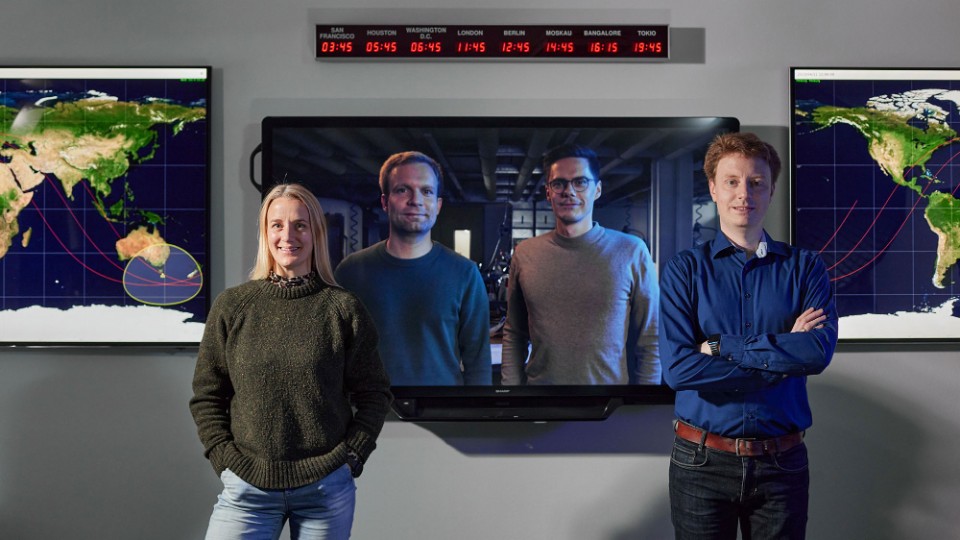Satellite technology – sustainable use of water in agriculture

Privacy warning
With the click on the play button an external video from www.youtube.com is loaded and started. Your data is possible transferred and stored to third party. Do not start the video if you disagree. Find more about the youtube privacy statement under the following link: https://policies.google.com/privacyWinner of the Fraunhofer Prize for “Human- and Environment-Centered Technology" 2023: Cassi Welling (constellr GmbH), Dr. Henrik von Lukowicz (Fraunhofer IOF), Dr. Matthias Beier (SPACEOPTIX GmbH) and Clemens Horch (Fraunhofer EMI) (from left to right).
Prize winners 2023:
Cassi Welling (constellr GmbH)
Dr. Henrik von Lukowicz (Fraunhofer Institute for Applied Optics and Precision Engineering IOF)
Dr. Matthias Beier (SPACEOPTIX GmbH)
Clemens Horch (Fraunhofer Institute for High-Speed Dynamics, Ernst-Mach-Institut, EMI)
70 percent of our drinking water is currently used for irrigation – more than half of this unnecessarily since the ground contains enough moisture. In the future, innovative satellite technology will ensure that plants are given only as much water as they need, leading to a more sustainable use of this essential resource. A prototype of the technology, LisR, has already been tested on the International Space Station (ISS).
In Germany, it’s taken for granted that there will always be enough water available. However, in the future, this essential resource could become scarce – after all, the Intergovernmental Panel on Climate Change predicts that, due to climate change, the intensity and frequency of droughts will increase along its current trajectory. In addition, the global population is also continuing to grow. It is estimated that, by 2050, the earth will be home to almost ten billion people – and those people will need food. This will be a challenge, as approximately 70 percent of our drinking water is currently used for irrigation. Most worryingly, 60 percent of this water is wasted due to overwatering.
Researchers from Fraunhofer Institute for High-Speed Dynamics, Ernst-Mach-Institut, EMI, the Fraunhofer Institute for Applied Optics and Precision Engineering IOF we well as the companies constellr GmbH and SPACEOPTIX – both spin-offs of these institutes – have taken inspiration from the founding principle of constellr GmbH to develop the infrared camera LisR (short for Longwave infrared sensing demonstratoR). Following a successful demonstration on the ISS, the findings from the LisR mission will now be used as the basis for building a satellite constellation. In the future, this satellite constellation will measure the land surface temperature from orbit and help adjust irrigation systems according to the level of water actually needed. As early as 2026, this method could save 180 billion tons of water and 94 million tons of CO2 per year, while supplying plants with the optimal amount of water could increase global harvests by up to 4 percent. This would produce enough additional food to feed over 350 million people.
Measuring the actual land surface temperature
But how does this technology actually help conserve such large quantities of water and CO2? It monitors the Earth’s surface and detects the infrared radiation that the surface emits. In doing so, it directly measures the land surface temperature, which enables researchers to draw conclusions on the water supply. The development was only possible through the collaborative efforts of the various partners with their complementary expertise. While Fraunhofer IOF developed compact optics that could easily be integrated into the camera module, SPACEOPTIX prepared the necessary freeform mirror optical systems with nanometer precision. For their part, the researchers at Fraunhofer EMI contributed a patented measuring process in which the camera images are used to determine the exact land surface temperature. The task of planning the mission and evaluating the data went to constellr GmbH.
Testing on board the ISS
In order to try out the new technology under real-life conditions, the researchers developed the LisR prototype. This was tested on the ISS in spring and summer of 2022 – a huge honor. From the ISS, the team was able to capture about ten million images, with a resolution of around 80 meters. The experts at constellr intend to build on this success by launching 16 small satellites by 2028 – these will be able to precisely measure the land surface temperature everywhere on the planet, with daily frequency, to a resolution of better than 50 meters. This support from space will allow farmers to determine the optimal amount of irrigation for their agricultural land.